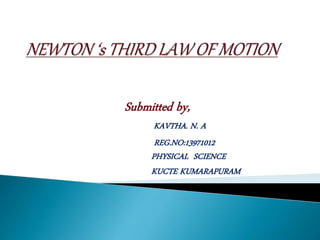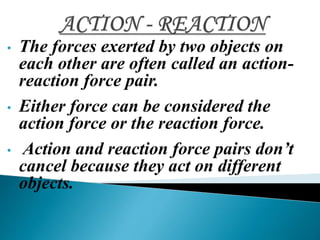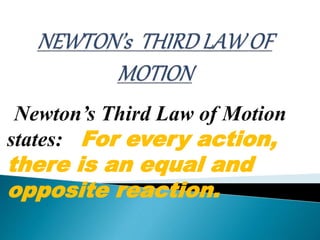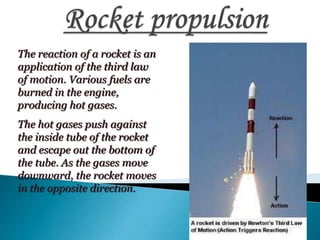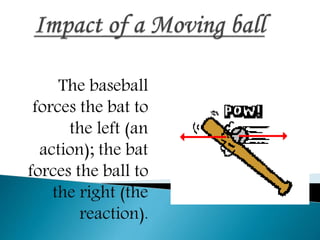Newton third law of motion ppt
- 2. Submitted by, KAVTHA. N. A REG.NO:13971012 PHYSICAL SCIENCE KUCTE KUMARAPURAM
- 3. ŌĆó The forces exerted by two objects on each other are often called an action-reaction force pair. ŌĆó Either force can be considered the action force or the reaction force. ŌĆó Action and reaction force pairs donŌĆÖt cancel because they act on different objects.
- 4. NewtonŌĆÖs Third Law of Motion states: For every action, there is an equal and opposite reaction.
- 5. The reaction of a rocket is an application of the third law of motion. Various fuels are burned in the engine, producing hot gases. The hot gases push against the inside tube of the rocket and escape out the bottom of the tube. As the gases move downward, the rocket moves in the opposite direction.
- 6. Consider the motion of a car on the way to school. A car is equipped with wheels which spin backwards. As the wheels spin backwards, they grip the road and push the road backwards.
- 7. The baseball forces the bat to the left (an action); the bat forces the ball to the right (the reaction).
- 8. Flying gracefully through the air, birds depend on NewtonŌĆÖs third law of motion. As the birds push down on the air with their wings, the air pushes their wings up and gives them lift.
- 9. ŌĆó Consider the flying motion of birds. A bird flies by use of its wings. The wings of a bird push air downwards. In turn, the air reacts by pushing the bird upwards. ŌĆó The size of the force on the air equals the size of the force on the bird; the direction of the force on the air (downwards) is opposite the direction of the force on the bird (upwards). ŌĆó Action-reaction force pairs make it possible for birds to fly.
- 10. ’üĮ Consider the propulsion of a fish through the water. A fish uses its fins to push water backwards. In turn, the water reacts by pushing the fish forwards, propelling the fish through the water. ’üĮ The size of the force on the water equals the size of the force on the fish; the direction of the force on the water (backwards) is opposite the direction of the force on the fish (forwards).
- 13. Hammer on the nail

